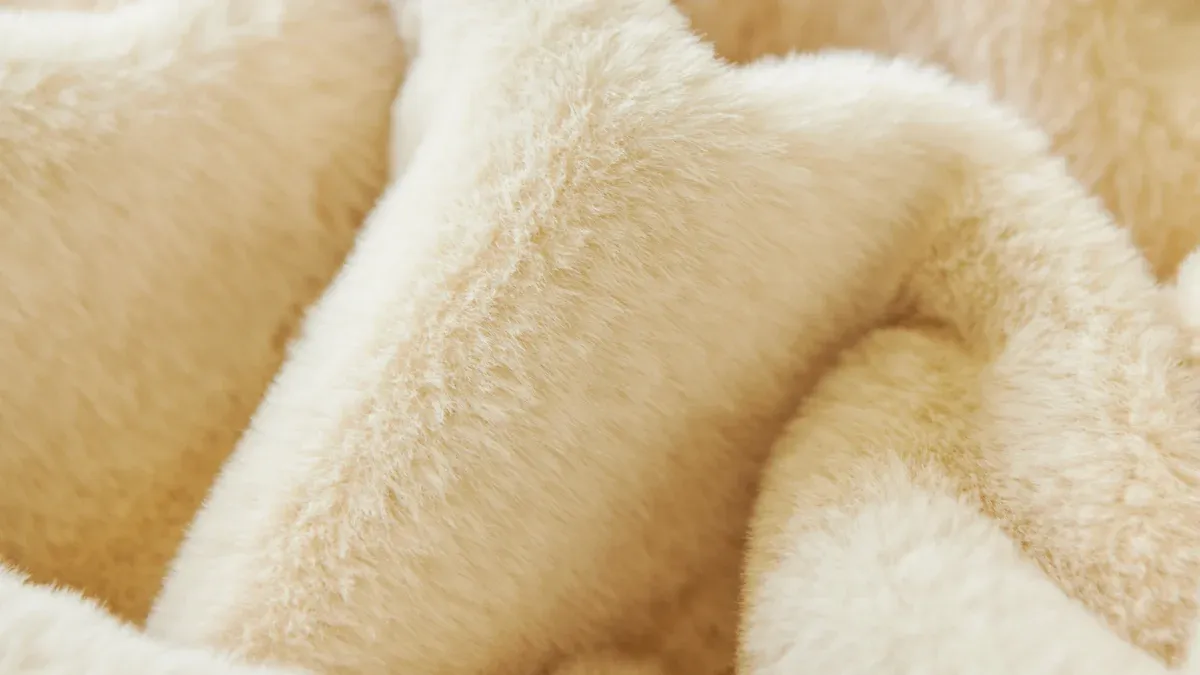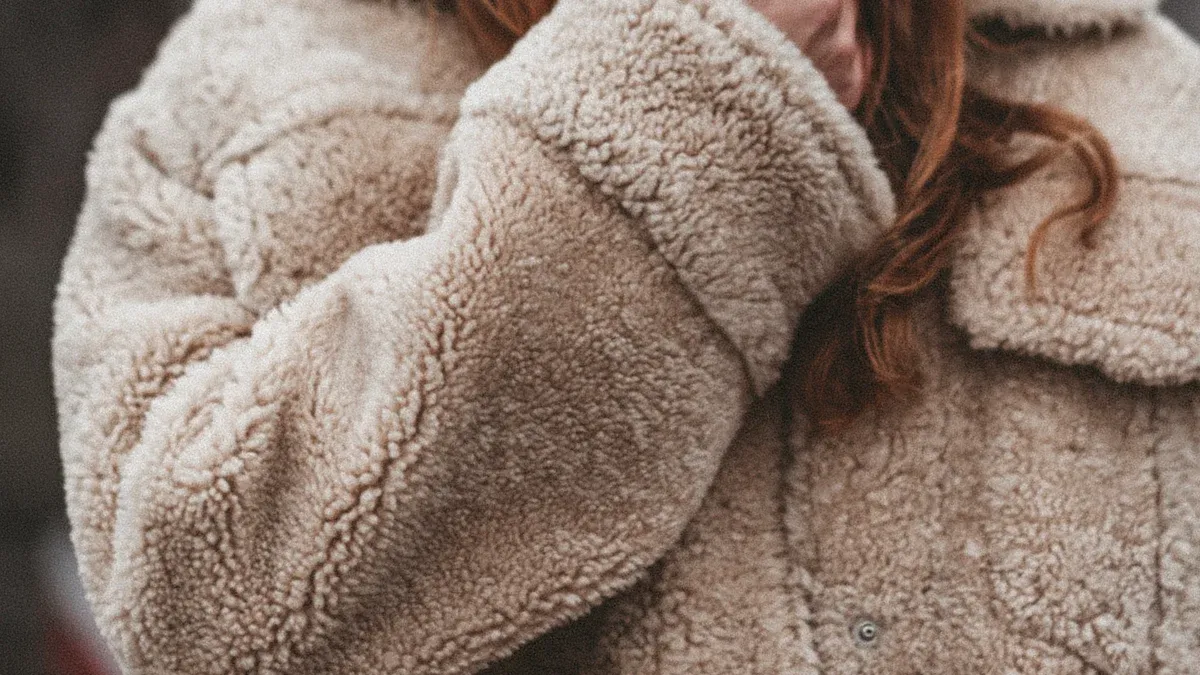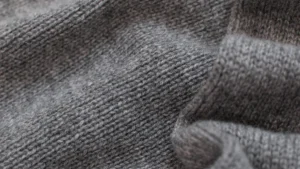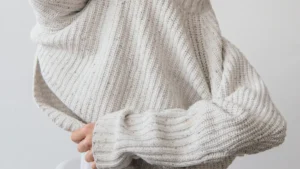
You can tell sherpa wool by its soft and fluffy feel. It feels like real sheep’s wool. Sherpa is made from synthetic fibers. It looks and feels warm like real wool. But it does not use animal products. This fabric became popular in the 1990s. It became trendy again in 2018 with celebrity partnerships. Sherpa and similar fabrics are now common in home items. People like them for chairs and blankets. They want cozy and soft textures. In Europe, sherpa’s special feel still draws designers and buyers. This keeps it stylish. Many people ask if sherpa wool is real wool. They also wonder how it compares to other fabrics for daily use.
Key Takeaways
Sherpa wool is very soft and warm. It is made from fake fibers. It feels like real sheep’s wool. But it does not use any animal products.
Sherpa fabric is simple to take care of. You can wash it in a machine. It dries fast and stays soft after many washes.
Sherpa gives more warmth than regular fleece or cotton. It also feels softer and thicker. This makes it great for cold weather clothes and cozy home things.
This fabric does not cause allergies. It is good for people with sensitive skin. But it can get fuzzy or lose fibers if not washed gently. You need to care for it the right way.
Picking sherpa helps support animal-free products. But it is not as good for the planet as natural fibers. Try to find recycled sherpa to help the environment.
Sherpa Wool Basics

What Is Sherpa Wool?
Sherpa wool feels soft and fluffy, like sheep’s fleece. It is not real wool. Factories make it from synthetic fibers like polyester or acrylic. Sherpa fabric copies the warmth and comfort of real wool. It does not use animal products. You often see sherpa in jackets, blankets, and slippers. It keeps you warm and cozy. The name comes from the Sherpa people in the Himalayas. They wore thick wool clothes to stay warm in the cold mountains. Now, sherpa wool gives that same warm feeling in modern clothes and home items.
Sherpa Wool vs. Real Wool
You might wonder how sherpa wool is different from real sherpa material. Real sherpa material comes from cashmere wool from Himalayan or Tibetan sheep. It feels soft, light, and gentle on your skin. Real sherpa is also good at blocking wind and almost keeps water out. Sherpa wool uses synthetic fibers instead. These fibers make one side fluffy and the other side smooth. This gives sherpa its special look and feel. Real wool comes from animals, but sherpa wool is cruelty-free and easier to clean. You can wash sherpa wool in a machine, and it dries fast. Real wool needs gentle cleaning and can shrink if you do not wash it right.
Feature | Sherpa Wool (Synthetic) | Real Sherpa Material (Natural) |
|---|---|---|
Source | Polyester, acrylic, or blends | Cashmere wool from Himalayan sheep |
Texture | Soft, fluffy, plush | Soft, light, skin-friendly |
Warmth | Excellent insulation | Superior insulation, wind-resistant |
Care | Easy, machine washable | Needs gentle care, may shrink |
Animal-Free | Yes | No |
Durability | Keeps shape and softness after washing | Long-lasting, but needs more care |
Key Features
Sherpa is special among synthetic fabrics for many reasons. It feels very soft and fuzzy, like real fleece. Sherpa holds warm air close to your body. This makes it great for cold days. The fabric lets air move, so you do not get too hot. Sherpa is light, so it does not feel heavy when you wear it. You can use sherpa for jackets, slippers, blankets, and pillows.
Sherpa has two sides: one is fluffy and wool-like, the other is smooth and knit.
The fluffy side keeps you warm in cold weather.
Sherpa is strong and stays soft and shaped after many washes.
The fabric is hypoallergenic and easy to clean, so it is good for sensitive skin.
Sherpa is reversible, so you get both style and function.
Sherpa is softer, warmer, and more stylish than other synthetic fabrics.
Tip: Do not iron sherpa or use high heat. This can ruin the soft, plush feel.
Sherpa is best for warm, cozy clothes and home items. Its soft feel and easy care make it a top pick for comfort and style.
Sherpa Fabric Production
Materials Used
When you look at sherpa, you see a fabric made mostly from synthetic fibers. Factories use polyester and acrylic as the main ingredients. Sometimes, they blend these with cotton to make the fabric even softer. Sherpa fabric first appeared in the 1970s as a way to copy the warmth and texture of sheepskin. Today, you find faux sherpa material in many jackets, blankets, and home goods. This type of fabric does not use animal products, so it fits well with vegan lifestyles.
How Sherpa Fabric Is Made
You might wonder how sherpa gets its fluffy, wool-like feel. The process starts with high-quality polyester. Factories knit this polyester into a flexible base. Next, they attach soft fibers to the base by weaving or tufting. This step creates the raised, plush side you love in sherpa. After that, the fabric goes through dyeing to add color. Workers then brush the surface to lift the fibers and make the sherpa extra soft. Finally, the fabric gets checked for quality. This includes tests for color, softness, and strength. Here is a simple list of the main steps:
Choose polyester or a blend as the base.
Knit the base fabric.
Add soft sherpa fibers by weaving or tufting.
Dye the fabric to the right color.
Brush the surface for a fluffy texture.
Inspect for quality and durability.
Faux sherpa material is different from real sheepskin or shearling. Real sherpa material comes from sheep and needs careful cleaning, shearing, and tanning. Faux sherpa material uses machines and synthetic fibers, so it takes less time and costs less to make.
Step | Sherpa Fabric (Faux Sherpa Material) | Shearling (Real Sherpa Material) |
|---|---|---|
Polyester, acrylic, cotton blends | Sheep hides | |
Processing | Machine-spun, dyed, brushed | Cleaned, sheared, tanned |
Animal-Free | Yes | No |
Production Time | Short | Long |
Eco and Vegan Aspects
Sherpa stands out as a vegan-friendly choice. You do not need animal products to enjoy its warmth and softness. Faux sherpa material gives you the cozy feel of wool without harming animals. However, you should know that sherpa fabric is made from petroleum-based fibers. This means it does not break down in nature and can add to microplastic pollution. Making sherpa also uses more energy and water than natural fabrics like wool or cotton. Some companies now use recycled polyester to lower the impact. If you want a vegan option, sherpa is a good pick, but it is not as eco-friendly as natural fibers.
Note: When you choose sherpa, you support animal-free products, but you should also think about the environment. Look for recycled options if you want to reduce your impact.
Sherpa Wool vs. Other Fabrics
Sherpa Wool vs. Sherpa Fleece
You may notice that sherpa and sherpa fleece look and feel similar. Both use synthetic fibers, often polyester or blends with cotton. Sherpa fleece fabric stands out for its curly, piled texture. It has two sides: one fluffy and one smooth. This design mimics natural sheepskin wool. Sherpa fleece traps warm air, making it bulkier and warmer than regular fleece. You often find sherpa fleece in linings for coats, gloves, and baby items. The table below shows the main differences:
Attribute | Sherpa Wool / Sherpa Fleece | Fleece (General) |
|---|---|---|
Material Composition | Polyester or blends, mimics sheepskin | Synthetic polyester |
Texture | Curly, piled, two-sided | Smooth, flat |
Warmth | Warmer, bulkier, traps heat | Lightweight, less thick |
Durability | Durable, needs gentle care | Durable, more breathable |
Weight/Thickness | Bulkier, thicker | Lighter, more versatile |
Cost | More expensive | More affordable |
Common Uses | Linings, blankets, baby items | Outerwear, jackets, blankets |
Sherpa vs. Fleece
The difference between sherpa and fleece comes down to texture and warmth. Sherpa fleece has a bumpy, wool-like surface that holds heat well. Fleece feels smoother and lighter. Sherpa fleece gives you distinctive warmth, but it breathes less than regular fleece. Fleece dries quickly and works well for layering. Sherpa fleece is best for cold weather, while fleece suits active wear and milder days. You may pay more for sherpa fleece because of its plush feel and warmth.
Sherpa vs. Cotton
Sherpa fabric keeps you warmer than cotton. The fluffy fibers in sherpa trap heat and create air pockets for insulation. Cotton feels soft and lets your skin breathe, but it does not hold warmth as well. You might choose sherpa for jackets, blankets, or sherpa lining in winter. Cotton works better for summer clothes and sheets. Sherpa blankets feel cozy and plush, while cotton blankets feel cool and light.
Warmth and Comfort
Sherpa fleece offers the highest warmth and plush comfort. You feel the thick, fluffy texture right away. Many people rate sherpa fleece as the best for cold weather. Fleece gives moderate warmth and feels lighter. Cotton feels soft but does not keep you as warm. Sherpa fleece lining in jackets or blankets makes a big difference on chilly days. Some users prefer sherpa fleece for its cozy feel, while others like fleece or cotton for breathability.
Durability and Care
Sherpa fleece stays soft if you care for it gently. Wash sherpa in cold water on a gentle cycle. Avoid bleach and fabric softeners. Air dry or use low heat to keep the fibers fluffy. Do not iron sherpa fleece. Fleece is easier to wash and dries fast. Cotton can handle more heat but may shrink. Sherpa fleece may pill or shed if you wash it too often or use high heat. Store sherpa items in a cool, dry place to keep them soft.
Tip: Brush sherpa fleece gently to keep it looking new. Wash sherpa blankets only once or twice a year for best results.
Sherpa fleece stands out for its warmth and comfort, but you need to care for it properly. Fleece and cotton offer easier care but less insulation. The difference between sherpa and fleece matters most when you want maximum warmth and a plush feel.
Uses and Benefits of Sherpa

Clothing and Outerwear
You see sherpa used in many cold-weather garments. This fabric keeps you warm and comfortable. Many brands use sherpa lining in coats and jackets. Some jackets use sherpa for the whole outer layer. You find sherpa jackets in many styles, from casual to dressy. Here are some popular clothing items that feature sherpa:
Coats and jackets with sherpa lining, like trucker jackets and corduroy jackets
Sherpa hoodies and fuzzy fleece jackets
Hiking boots with sherpa trim or lining
Accessories such as crossbody bags with sherpa details
Sherpa jackets, like the Levi’s Original Sherpa Trucker Jacket or Madewell Sherpa-Lined Corduroy Jacket, show how this fabric works in both fashion and function. You get warmth, style, and a cozy feel.
Home Goods
Sherpa brings comfort to your home. You often find it in blankets, throws, and pillows. A sherpa blanket feels soft and plush, perfect for cold nights. Many people use sherpa for chair covers or pet beds. The fabric adds a cozy touch to any room. You can also find sherpa in slippers and robes, making your mornings warmer and more comfortable.
Tip: Use a sherpa blanket for movie nights or as an extra layer on your bed during winter.
Advantages and Drawbacks
Sherpa offers many benefits, but you should know its drawbacks too. Here is a quick look:
Advantages | Drawbacks |
|---|---|
Keeps you warm | Can pill or shed if not cared for |
Soft and lightweight | May trap odors if not washed properly |
Easy to clean | Not as eco-friendly as natural fibers |
Hypoallergenic | Made from synthetic materials |
Animal-free | Can contribute to microplastic pollution |
You get warmth and comfort from sherpa, especially in cold-weather garments. The fabric is easy to care for and works well for people with sensitive skin. However, you should wash it gently to keep it soft and avoid shedding. Sherpa does not use animal products, but it is not biodegradable like real wool. If you want a cozy, stylish option, sherpa works well for both clothing and home goods.
You have learned how sherpa wool is different from other fabrics. The table below shows the main differences:
Factor | Sherpa Wool (Synthetic) | Shearling (Natural) |
|---|---|---|
Warmth | Good insulation | Exceptional insulation |
Comfort | Soft, lightweight, easy care | Very comfortable, needs care |
Durability | Durable, less long-lasting | Lasts for years |
Budget | Affordable | More expensive |
Ethics | Animal-free, recycled options | Animal-derived |
Maintenance | Machine washable | Needs professional cleaning |
Pick sherpa if you want:
Something soft, light, and not too pricey
Fabric that is simple to wash in a machine
Think about what you need for warmth, comfort, and the planet before you choose.
FAQ
Is sherpa wool real wool?
Sherpa wool is not real wool. Factories make it from synthetic fibers like polyester or acrylic. You get the look and feel of wool without using animal products.
Can you wash sherpa fabric in a washing machine?
Yes, you can wash sherpa fabric in a machine. Use cold water and a gentle cycle. Air dry or use low heat. Avoid bleach and fabric softeners to keep it soft.
Does sherpa fabric shed or pill?
Sherpa fabric may shed or pill if you wash it too often or use high heat. You can reduce this by washing gently and brushing the fabric after drying.
Is sherpa fabric good for people with allergies?
Sherpa fabric is hypoallergenic. You can use it if you have sensitive skin or allergies. It does not trap dust or pet hair as much as some natural fibers.
How does sherpa compare to fleece for warmth?
Sherpa feels warmer and thicker than regular fleece. You get more insulation from sherpa, which makes it a better choice for cold weather. Fleece feels lighter and works well for layering.









